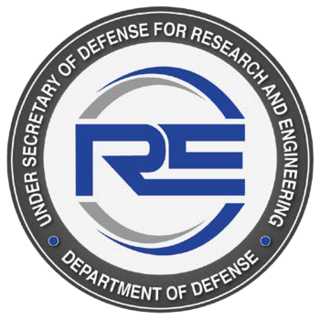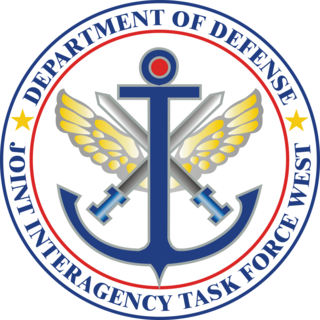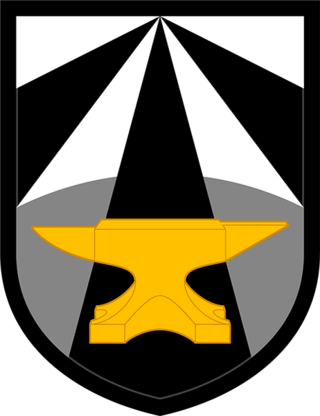Related Research Articles

The Joint Chiefs of Staff (JCS) is the body of the most senior uniformed leaders within the United States Department of Defense, that advises the president of the United States, the secretary of defense, the Homeland Security Council and the National Security Council on military matters. The composition of the Joint Chiefs of Staff is defined by statute and consists of a chairman (CJCS), a vice chairman (VJCS), the chiefs of the Army, Marine Corps, Navy, Air Force, Space Force, and the chief of the National Guard Bureau. Each of the individual service chiefs, outside their JCS obligations, works directly under the secretaries of their respective military departments, e.g. the secretary of the Army, the secretary of the Navy, and the secretary of the Air Force.
A cross-functional team, also known as a multidisciplinary team or interdisciplinary team, is a group of people with different functional expertise working toward a common goal. It may include people from finance, marketing, operations, and human resources departments. Typically, it includes employees from all levels of an organization. Members may also come from outside an organization.
CFT may refer to:

United States Space Command is a unified combatant command of the United States Department of Defense, responsible for military operations in outer space, specifically all operations 100 kilometers and greater above mean sea level. U.S. Space Command is responsible for the operational employment of space forces that are provided by the uniformed services of the Department of Defense.

The United States Army Space and Missile Defense Command (USASMDC) is an Army Service Component Command (ASCC) of the United States Army. The command was established in 1997. The current USASMDC commander is Lieutenant General Daniel L. Karbler with Senior Enlisted Advisor Command Sergeant Major Finis A. Dodson.

The Department of Defense Architecture Framework (DoDAF) is an architecture framework for the United States Department of Defense (DoD) that provides visualization infrastructure for specific stakeholders concerns through viewpoints organized by various views. These views are artifacts for visualizing, understanding, and assimilating the broad scope and complexities of an architecture description through tabular, structural, behavioral, ontological, pictorial, temporal, graphical, probabilistic, or alternative conceptual means. The current release is DoDAF 2.02.
A United States defense standard, often called a military standard, "MIL-STD", "MIL-SPEC", or (informally) "MilSpecs", is used to help achieve standardization objectives by the U.S. Department of Defense.

The Office of the Secretary of Defense (OSD) is a headquarters-level staff of the United States Department of Defense. It is the principal civilian staff element of the U.S. Secretary of Defense, and it assists the Secretary in carrying out authority, direction and control of the Department of Defense in the exercise of policy development, planning, resource management, fiscal, and program evaluation responsibilities. OSD is the Secretary of Defense's support staff for managing the Department of Defense, and it corresponds to what the Executive Office of the President of the U.S. is to the U.S. president for managing the whole of the Executive branch of the federal government.

The United States under secretary of defense for policy (USDP) is a high level civilian official in the United States Department of Defense. The under secretary of defense for policy is the principal staff assistant and adviser to both the secretary of defense and the deputy secretary of defense for all matters concerning the formation of national security and defense policy.
The Assistant Secretary of Defense for Networks & Information Integration was an appointed position that provided management and oversight of all DoD information technology, including national security systems. The ASD(NII) also served as the chief information officer (CIO) of the United States Department of Defense (DoD), a position distinct from the ASD and governed by the Clinger-Cohen Act.
The Information Technology Management Reform Act of 1996 is a United States federal law, designed to improve the way the federal government acquires, uses and disposes information technology (IT). It was passed as Division E of the National Defense Authorization Act for Fiscal Year 1996. Together with the Federal Acquisition Reform Act of 1996, it is known as the Clinger–Cohen Act.

The under secretary of defense for intelligence and security or USD(I&S) is a high-ranking civilian position in the Office of the Secretary of Defense (OSD) within the U.S. Department of Defense (DoD) that acts as the principal civilian advisor and deputy to the secretary of defense (SecDef) and deputy secretary of defense (DepSecDef) on matters relating to military intelligence and security. The under secretary is appointed as a civilian by the president and confirmed by the Senate to serve at the pleasure of the president.

The Designated Senior Official (DSO), also referred to as the Senior Designated Official (SDO) or Designated Civilian Official (DCO), is an additional duty or responsibility assigned to officials within governments. The designation, often mandated in legislation, requires the official to take a direct role in a priority initiative, program, or project, ensuring that sufficient importance, support and oversight is provided.

The Under Secretary of Defense for Research and Engineering, abbreviated USD (R&E), is a senior official of the United States Department of Defense. The USD (R&E) is charged with the development and oversight of technology strategy for the DoD. The post has at various times had the titles Assistant Secretary of Defense for Research and Engineering, or Director of Defense Research and Engineering (DDR&E). The latter title has itself historically varied between the rank of under secretary and that of assistant secretary.

Joint Interagency Task Force West is a standing United States military joint task force with the mission of combating drug-related transnational organized crime in the Indo-Asia-Pacific. JIATF West's area of responsibility (AOR) is that of United States Indo-Pacific Command (USINDOPACOM). JIATF West is one of two Joint Interagency Task Forces with a counter-narcotics mission. The other is Joint Interagency Task Force South. The task force is run as USPACOM's "executive agent" for counterdrug activities providing support to partner nation law enforcement. Approximately 100 active duty and reserve U.S. military forces; Department of Defense civilian employees; contractors; and U.S. and foreign law enforcement agency personnel are members of the task force.

The Air Force Installation and Mission Support Center (AFIMSC), headquartered at Joint Base San Antonio-Lackland (JBSA-Lackland), Texas, is one of six centers aligned under Air Force Materiel Command for the United States Air Force. AFIMSC serves as the single intermediate-level headquarters responsible for providing installation and mission support to 77 Air Force installations, nine major commands and two direct reporting units with an annual budget of approximately $10 billion. The center comprises four directorates, 10 detachments, and four primary subordinate units, or PSUs. The AFIMSC cross-functional team provides globally integrated management, resourcing and combat support operations for Airmen and family services, base communications, chaplain, civil engineering, contracting, logistics readiness, public affairs, security forces and financial management programs.

The Federal Risk and Authorization Management Program (FedRAMP) is a United States federal government-wide program that provides a standardized approach to security assessment, authorization, and continuous monitoring for cloud products and services.

The United States Army Futures Command (AFC) is a United States Army command, designed as a public-private initiative, that runs modernization projects for the Army. It is headquartered in Austin, Texas, and was first commanded by General John Murray, formerly the Army's G-8; the second and current commander was formerly the Army's G-3/5/7.

The United States Army Acquisition Corps (AAC) is the officer / NCO corps of the United States Army Acquisition Workforce (AAW), a branch which includes civilians, officers, and NCOs. The Acquisition Corps is composed of army officers who serve in acquisition, a specialized form of product development, fielding, and support and Noncommissioned Officers who specialize in Contracting, Level I Program Management and Purchasing. These officers begin their careers in the other branches of the army for eight years, after which they may elect the Acquisition branch as their career as assistant program managers (APMs), program managers (PMs), and program executive officers (PEOs). The Noncommissioned Officers (NCOs) are reclassified in the Army Acquisition NCO Corps after serving 7-10 years in their respective enlisted career management fields, and serve primarily in the Army Acquisition Career Management Field - 51 and (MOS) 51C. 4% percentage of the Army Acquisition Officers serve among the 40,000 members of the army acquisition workforce, 6% in MOS 51C - Acquisition, Logistics and Technology Contracting Noncommissioned Officer, and the remainder 90% percentage consist largely of Department of the Army civilians.
References
![]() This article incorporates public domain material from websites or documents of the United States Government .
This article incorporates public domain material from websites or documents of the United States Government .
![]() This article incorporates public domain material from websites or documents of the United States Department of Defense .
This article incorporates public domain material from websites or documents of the United States Department of Defense .
- ↑ Terri Moon Cronk. "Defense Secretary Asks DoD to Seek Organizational Efficiencies." DOD News. https://www.defense.gov/Explore/News/Article/Article/1089561/defense-secretary-asks-dod-to-seek-organizational-efficiencies/
- ↑ GAO-18-513: Defense Management. https://www.hsdl.org/?abstract&did=812436
- ↑ Public Law 114–328. https://www.congress.gov/114/plaws/publ328/PLAW-114publ328.pdf
- ↑ https://www.govexec.com/media/gbc/docs/pdfs_edit/establishment_of_the_awcft_project_maven.pdf [ bare URL PDF ]
- ↑ Organizational Chart. OUSD-I. https://ousdi.defense.gov/About-Us/Organization/
- ↑ SECDEF Memo: Establishment of the Close Combat Lethality Task Force (CCLTF). https://www.esd.whs.mil/Portals/54/Documents/DD/issuances/dtm/DTM-18-001.pdf?ver=2018-12-31-075206-870
- ↑ SECDEF Memorandum: Establishment of the Protecting Critical Technology Task Force. https://s3.amazonaws.com/fedscoopwp-media/wp-content/uploads/2018/11/01155310/DOD-Supply-Chain-Memo.pdf
- ↑ Brad Williams (5 Aug 2021) Secretary Austin Approves Spectrum Superiority Strategy Implementation Plan
- ↑ Secretary of Defense Memorandum. Establishment of the Electromagnetic Spectrum Operations Cross Functional Team. (Feb. 2, 2019)
- ↑ Sydney Freedberg. (18 December 2019) Who’ll Fix EW? Task Force Gropes For Answers. Breaking Defense.
- ↑ Joseph Evans and Dan Patt (23 Nov 2021) For JADC2, the Pentagon should learn from the 5G community
- ↑ HR 5515. https://www.congress.gov/115/bills/hr5515/BILLS-115hr5515enr.pdf
- ↑ SECDEF Memorandum. Guidance on Secretary of Defense-Empowered Cross-Functional Teams. 2 December 2019
- ↑ SECDEF Memorandum. Guidance on Secretary of Defense-Empowered Cross-Functional Teams. 2 December 2019
- ↑ SECDEF Memorandum. Guidance on Secretary of Defense-Empowered Cross-Functional Teams. 2 December 2019
- ↑ SECDEF Memorandum. Guidance on Secretary of Defense-Empowered Cross-Functional Teams. 2 December 2019
- ↑ SECDEF Memorandum. Guidance on Secretary of Defense-Empowered Cross-Functional Teams. 2 December 2019
- ↑ SECDEF Memorandum. Guidance on Secretary of Defense-Empowered Cross-Functional Teams. 2 December 2019